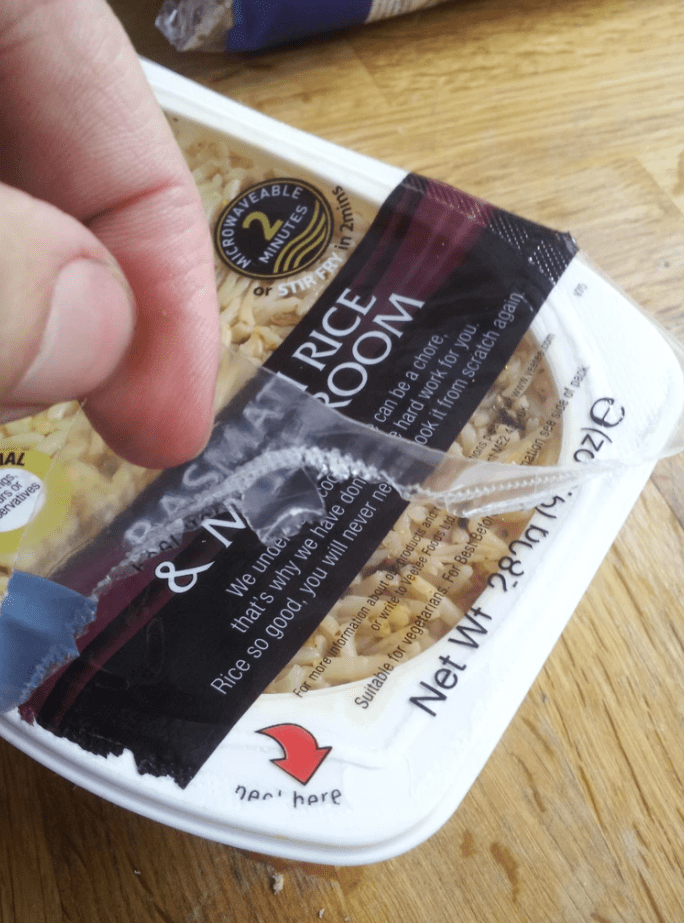I think about digital marketing A LOT and I’m also easily irritated by everyday experiences. So much so that when I find myself in a pot of slightly frustrating bother, I often think to myself “what lesson can I learn from this and how can I apply it to my digital marketing abilities?
… Just hang on in there and it will all make sense!
Strap yourselves in and get ready to hear me moan about 3 moderately bothersome IRL scenarios and then brute force 3 digital marketing lessons into them.
Scenario 1: When the pull tab disappears from the milk
Picture the scene: it’s Sunday, you’ve had an amazing weekend but now it’s time to chill and try not to think about work tomorrow. You’re desperate for a cup of your favourite tea. The boiling water is in, the bag has steeped for at least a minute, and you’ve conjured a mini cyclone by stirring the mug ferociously. You reach for a brand-new milk, unscrew the top and proceed to look for the pull tab required to whip off the plastic seal. But what’s this? There is no plastic tab.

For the next 45 seconds you’re in an eternal struggle as you frantically attempt to pick and peel at a disc of plastic sealed so tight, not even 10 supermen could help.
Unnecessary assumptions
As you desperately grab at it betwixt finger and thumb your mind races over the possible reasons behind this most heinous of crimes:
- How did they forget to put the little tab on AGAIN?
- Did it gain sentience, remove itself and is now living a life of freedom, away from the forced responsibilities of preserving milk?
- Is no one employed in the factory specifically to safeguard against missing / sentient pull tabs?
- Is this a cost-saving exercise? If so, what’s next, the plastic seal itself? But then the milk will go everywhere! They can’t do this; I’m going to start a petition or GoFundMe page or something…
- Did one of my cats sneak into the fridge at night and swipe it off with their deftly claws?
Then it hits you, what if the answer is even closer to home? You turn over the lid and BAM!

Now you feel stupid, you’re still angry that there isn’t someone hired specifically to ensure this never happens, but you also can’t believe it’s taken so long to figure out where the pull tab has been hiding all this time.
Digital marketing lesson 1: Swap unnecessary assumptions for data
OK, at this point the scenario might be less relatable, as you probably figured it out instantly. But for me, this didn’t just happen once. No, no, I’ve struggled to open many a milk in a fit of rage and unresolved anger. But nowadays it’s all so clear to me. If I had just stopped to think (sensibly) for a second and hadn’t got carried away with unnecessary assumptions, I might have landed on what was the simplest answer sooner.
You might be thinking: “Didn’t that bloke who got famous selling hair removal instruments propose a similar theory way back when?”
To which I would reply: “You mean Occam’s Razor? Yes, but the only link between him and Gilette would be his suggestion of shaving away unnecessary assumptions when distinguishing between two theories”.
In any case, this lesson goes one step further. The beauty of digital marketing is that with the correct tracking set-up, we don’t have to rely on assumptions – we can investigate using data. Whether that’s a report from GA4 or key insights from user research, the field of digital marketing lets us strip away the assumed and unknown in favour of cold, hard facts to answer our most important questions.
GA4: 3, 2, 1, GO!
Let’s look at GA4 for example, there are a multitude of handy reports, and even the ability to build custom ones from scratch via the Explore tool. That feature goes far beyond what was possible with Universal Analytics.
One of my favourite reports in Google Analytics is the conversion paths tool. Let’s say that there have been some assumptions made about the performance of paid search, due to the GA4 numbers in the latest monthly report.
Head over to Advertising > Attribution > Conversion paths and you can drill down into the channels, campaigns and anything else that is contributing to conversions. This report can be an eye-opener, as you start to see some of the common journeys users are taking on their way to convert.

Perhaps there’s a particular synergy between an organic social post or a specific email and one of your PPC campaigns. These insights could inform future cross-channel strategies and deliver even more conversions.
If you need help with your analytics strategy then check out our ultimate GA4 guide.
Scenario 2: When they don’t pull a fill line on your instant noodle pot
It’s a cold, wet and windy Monday at work. You’re tired, stressed and oh so hungry, then suddenly you remember you have a pot of instant noodles for lunch. And look, it’s 11:59am – what a result!
You skip gleefully over to the kettle and get it boiled quick-fast. You simultaneously prepare your delightfully simple ramen noodles, joyfully peeling off the lid and taking out the various sachets of herbs, sauce and other dried ingredients when your smile suddenly drops.

THEY DIDN’T PUT A FILL LINE ON THE POT! What a cruel and twisted turn of fate. How are you ever going to pour the right amount of boiling water to get your noodles tasting just the way you like them? At this point, no one could tell whether you’re about to get one of the two following consistencies:
- Way too watery
- Super swollen and stodgy
You look down and realise that this whole time, you’ve continued to pour water into the pot and the noodles are now making a hasty, watery exit.
The kettle is empty, but your tears continue to stream down into your noodle broth, making it even saltier. You had one objective: To eat a tasty lunch, but the noodle company wouldn’t let you.
Digital marketing lesson 2: Define your objectives and make sure you can measure them
Both in life and digital marketing, having an objective helps you focus on what matters most, whether that’s revenue, brand awareness or the perfect instant noodles. But how are we going to get the outcome we desire if we have no way of measuring it? That’s where goal tracking comes in.
Using revenue as an example, by setting up macro (transactions and revenue) and micro goals (add to cart and product detail page views), we can ensure that your digital marketing activity is driving the kind of success we’re aiming for.
A measured effort
Let’s say that our main objective is brand awareness. In this scenario, there are a few different ways to measure against it, combining a mix of macro and micro goals.
Macro goal: Average monthly search volume for pure brand keywords.
More people searching for your brand is a very clear signal that awareness is increasing. However, it’s important to place context with this goal. If your brand is seasonal then it’s best to compare year-on-year results, if not then seeing a rise month-on-month would be indicative.
This goal is something that can easily be measured for free with Google Ads’ keyword planner tool. Just select the get search volume and forecasts option, add in your brand keywords, and choose the right location. Then, you can see how search volumes fluctuate over time.

Micro goals: Increase in social followers and increase in direct traffic.
Whilst these goals are suggestive of an increase in brand awareness, there could be other factors which are also behind them. For example, perhaps you’re running a promotion which requires users to follow your brand’s social channels. Sure, there’s some brand awareness happening as a result, but the focus of that kind of campaign is likely to be revenue.
With direct traffic, it’s essentially where GA puts data that doesn’t have a home. Sure, some of that will be from users searching for the brand’s website directly, but not all of it.
However, if you measure macro and micro goals together, you can potentially start to tell a story of growing brand awareness.
Scenario 3: When the ready meal plastic won’t peel off
Disclaimer: Get ready, because is by far the most annoying one out of the lot, you have been warned!
It’s Friday night, the end of a long week and you just want to put your feet up in front of the TV and gobble up your ready-made dinner from the very plastic trough it was cooked in. You’ve followed the instructions to the letter and so far, EVERYTHING has gone to plan. You made a sensible number of holes in the plastic film, you stopped the microwave halfway to give it a stir, and you’ve even left it to cool for the suggested 1 minute (you absolute maverick).
All that’s left is to open that sucker up so you can enjoy the tasty goodness that awaits you. With bated breath, you begin to peel from one corner of the tray. But what’s this?

Nothing but edge, the film on top has given up with a whimper and a minor tug only removes a thin outline of the whole plastic. But it’s ok, there’s three more corners to attempt.
You carefully pull at corner number two and it starts to lift off, RESULT! But what’s this now? A multi-tear? You hear the suggestion of “piercing the film in several places” mock you as the top is now essentially 95% pierced.
Your only course of action now is to peel away at least 1,000 strands of thin, food-covered plastic, making sure not to accidentally poke a finger in your cannelloni (thank God you let it cool for 1 minute)!
The deed is done, you can access your ready meal, but at what cost? The dinner is consumed passively, it just slips down with barely a single taste bud engaged. They’re all far too bitter & traumatised to convey any sense of joy to your brain. You cry yourself to sleep on the sofa, swearing you’ll never purchase that particular brand of microwave meal again.
Digital marketing lesson 3: Understand and optimise your user experience
I’m so sorry you had to read and most likely relive all of that. It’s a situation I wouldn’t wish on my worst enemy. I’ve had the exact opposite experience with some ready meals and I can’t even begin to describe the elation and relief that’s felt when the film just peels clean off in one go… which is why it’s important to understand your users’ experience in digital marketing .
Every digital strategy should make space for some kind of user research. That could be in the form of heatmaps on key landing pages, website surveys or even face-to-face user interviews. Being able to identify and resolve pain points and user frustrations can lead to some dramatic improvements in key objectives.
Be careful when handling the jar
A great tool for this is HotJar, which lets you measure user experience in a multitude of ways. A particular favourite is the surveys feature, which allows you to gather invaluable feedback as users browse your website.
You could set up a short and simple two-question survey, which only appears when a user is about to leave your website. For example, the questions could be:
1. How would you rate your experience?
![]()
2. Tell us about your experience…
{Long text answer}
This survey doesn’t have to only appear when the user is about to leave the site. It could fire on a specific page or set of pages. It could also be triggered to keep appearing until the user responds, just once or continually, even after a response.
Keeping the survey short is the key to higher response rates, and with user experience, the more data the better. The next step is to perform some thematic analysis on the results.
Simply export the data, open it in Excel and start grouping the responses into themes. You’ll quickly start to see pain points and frustrations that are common amongst users and might require a resolution as a priority.
We have a fantastic team of UX experts waiting to help with your biggest challenges. Why not get in touch and see what they can do?
Real life is frustrating, your digital marketing strategy doesn’t have to be
So, there you have it, a small window into my easily infuriated mind and some key takeaways for your digital strategy. Now, I’m just going to go and open a fresh bottle of tomato ketchup, I wonder what lessons await me there!
Escape the frustrations of real life and embrace the power of digital marketing. Our dedicated team of strategy experts and digital marketing specialists are here to make your journey as effortless as possible. Get in touch with us today to unlock a world of possibilities.
